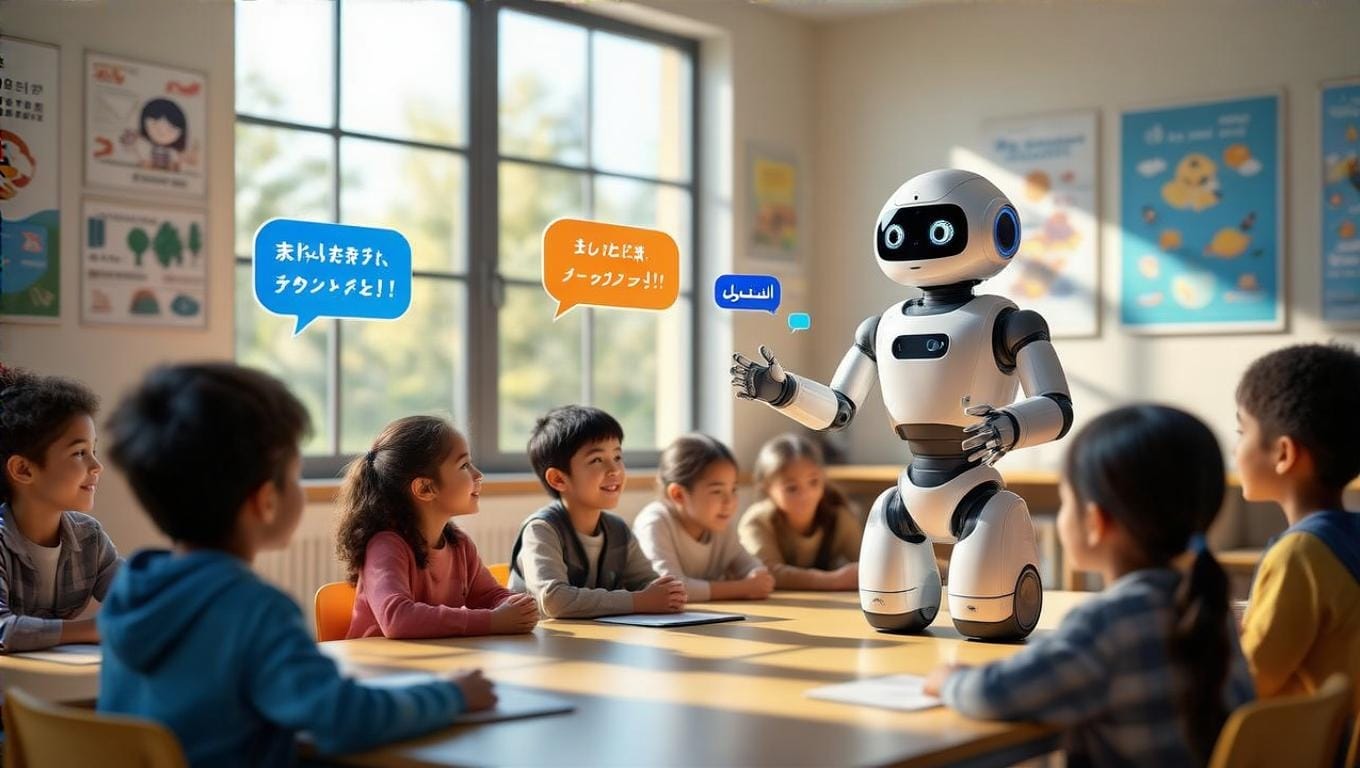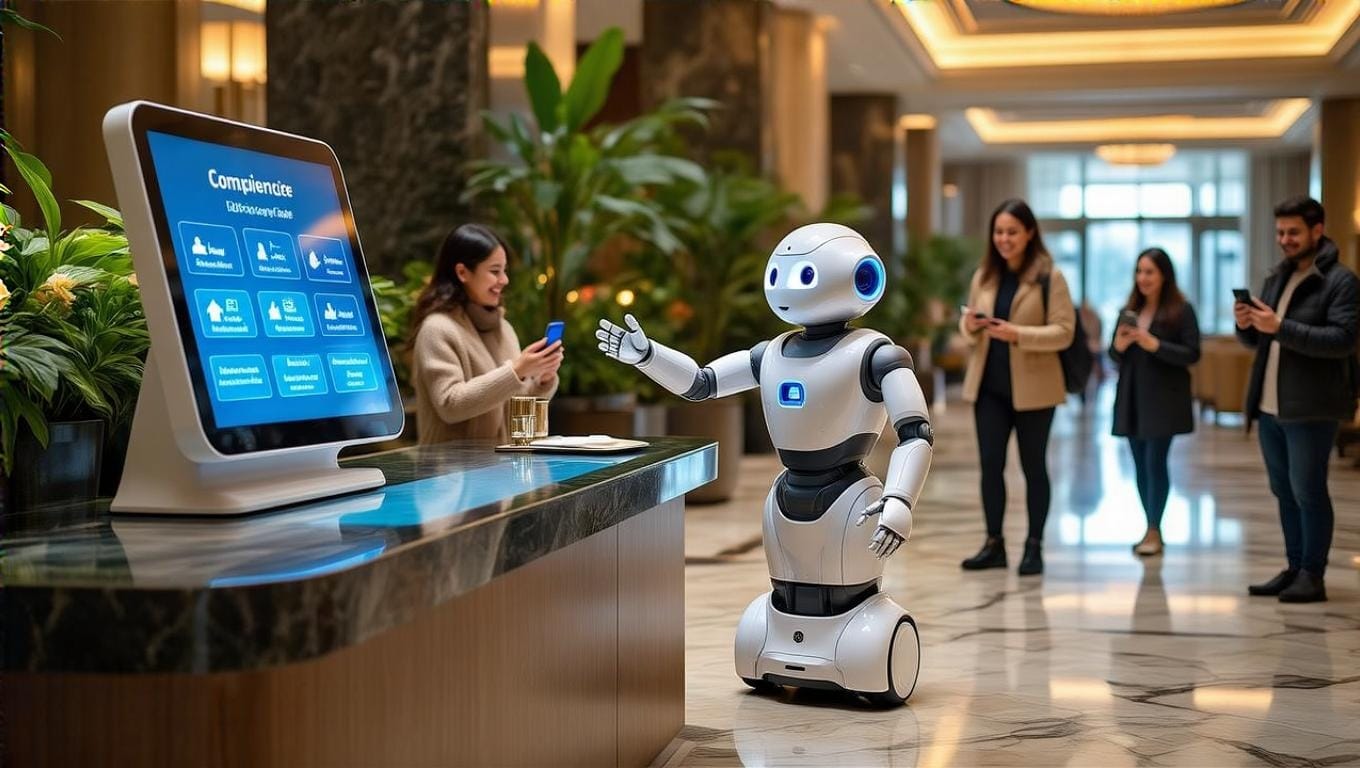Answer just a few questions and we'll have you matchedwith your perfect Companion Robot!Click now for your FREE custom report!
Multi-Lingual Companion Robots: Breaking Language Barriers in Global Homes

Breaking Language Barriers: How Multi-Lingual Companion Robots Are Revolutionizing Global Homes
Ever felt like you needed a babel fish from “The Hitchhiker’s Guide to the Galaxy” to navigate our increasingly multilingual world? Well, folks, the future is now, and it’s speaking your language – literally. Multi-lingual companion robots are here, and they’re not just breaking language barriers; they’re smashing them to smithereens.
The Rise of Polyglot Bots

Remember when we thought talking robots were just the stuff of sci-fi? Now, they’re hanging out in our living rooms, chatting away in multiple languages like some kind of mechanical United Nations delegates. These multi-lingual companion robots are changing the game for international users faster than you can say “Alexa, how do you say ‘I’m hungry’ in Mandarin?”
According to a recent report by The Business Research Company, the global companion robot market is expected to grow at a CAGR of 18.84% between 2021 and 2026. That’s faster than my grandma’s gossip spreads at a family reunion!
Why Multi-Lingual Robots? Because the World’s a Big, Chatty Place

In our globalized world, language barriers are about as welcome as a skunk at a garden party. Enter multi-lingual companion robots, the ultimate ice-breakers for international households. These polyglot pals are perfect for:
- Expat families trying to keep up with local lingo
- Multilingual households juggling different languages
- Language learners looking for a 24/7 practice buddy
- Businesses aiming to provide seamless customer service across borders
Features That’ll Make You Say “Wow” in Multiple Languages

These linguistic virtuosos come packed with more features than a Swiss Army knife. Here’s what makes them the talk of the town (in any language):
- Real-time translation: Faster than you can say “lost in translation”
- Voice recognition: They’ll know it’s you, even with your terrible French accent
- Cultural context understanding: No more accidental faux pas!
- Multi-modal communication: Because sometimes, you need to see it to believe it
- Continuous learning: They get smarter with every chat, like a nerdy friend who never sleeps
The Big Players in the Polyglot Robot Game

Who’s leading the charge in this linguistic revolution? Let’s meet the stars of the show:
- iFLYTEK: This Chinese company’s companion robots can understand and speak multiple languages, making them perfect for international homes.
- Softbank Robotics: Their famous Pepper robot now comes with a multilingual upgrade, speaking 15 languages fluently.
- LG CLOi: This cute little bot can serve as a multilingual concierge, perfect for hotels catering to international guests.
Real-World Applications: More Than Just Small Talk

These multi-lingual companion robots aren’t just fancy toys. They’re making real impacts in various sectors:
Education
Imagine a robot tutor that can switch between languages seamlessly, helping kids become global citizens from the comfort of their homes. It’s like having Mary Poppins, but with circuits instead of magic.
Healthcare
In hospitals with diverse patient populations, these robots can assist in providing care instructions in multiple languages. No more playing charades with your doctor! Robots in healthcare are already seeing implementation for language support, as reported by Global Market Insights.
Tourism
Hotels and tourist spots are using these polyglot bots to provide information and assistance in multiple languages. It’s like having a pocket-sized tour guide that never gets tired or asks for tips. For example, Chinese tourism initiatives are already testing robot-based multilingual concierge services.
Business
International companies are using these robots for multilingual customer service and to facilitate communication between global teams. It’s bringing “think global, act local” to a whole new level.
The Challenges: It’s Not All Smooth Talking
Of course, it’s not all roses and perfectly pronounced R’s in the world of multi-lingual companion robots. There are some hurdles to overcome:
- Accuracy: Sometimes these bots might confuse “I’m fine” with “You’re fired.” Oops!
- Cultural nuances: Sarcasm and idioms can be trickier than a game of Twister for these robots. Learn more about these challenges in robot-human interactions.
- Privacy concerns: Having a polyglot pal that listens to everything might make some folks a bit nervous.
- Cost: High-end models can be pricier than a year’s worth of language classes.
The Future: A World Where Everyone Understands Each Other?
As these multi-lingual companion robots for international users continue to evolve, we might be looking at a future where language barriers become as obsolete as floppy disks. Imagine a world where:
- International business deals are closed without a hitch
- Cross-cultural friendships bloom effortlessly
- Global education becomes truly accessible
- Traveling feels less like an episode of “Lost in Translation”
Wrapping It Up: The Universal Language of Progress
Multi-lingual companion robots for international users are more than just cool gadgets. They’re the bridge-builders of our global village, turning “lost in translation” moments into opportunities for connection and understanding.
As these polyglot pals continue to learn and grow, they’re not just changing how we communicate – they’re changing how we see the world and each other. And in a world that sometimes feels more divided than ever, that’s something worth talking about – in any language.
So, whether you’re a globe-trotting businessperson, a curious language learner, or just someone who wants to chat with their multilingual neighbor, these robots are here to help. They’re breaking down walls, one word at a time, proving that in the end, we all speak the same language: the language of human connection.
And who knows? Maybe one day, these companion robots will be so good, they’ll even understand my aunt’s thick Scottish accent. Now that would be a true miracle of modern technology!



